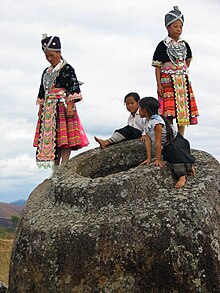Muang Phuan
Principality of Phuan ເມືອງພວນ ( Muang Phuan | |||||||||
|---|---|---|---|---|---|---|---|---|---|
| Common languages | Lao | ||||||||
| Religion | Buddhism | ||||||||
| Government | Monarchy | ||||||||
| King | |||||||||
• 1651–1688 | Kham Sanh | ||||||||
• 1880–1899 | Kham Ngon (last) | ||||||||
| History | |||||||||
• Established | 13th century | ||||||||
• French Protectorate | 1893 | ||||||||
| 1899 | |||||||||
| Currency | Hoi | ||||||||
| |||||||||
| Today part of | Laos Vietnam | ||||||||
| History of Laos | ||||||||
|---|---|---|---|---|---|---|---|---|
 | ||||||||
| Muang city-states era | ||||||||
|
||||||||
| Lan Xang era | ||||||||
|
||||||||
| Regional kingdoms era | ||||||||
|
||||||||
| Colonial era | ||||||||
|
||||||||
| Independent era | ||||||||
|
||||||||
| See also | ||||||||
Muang Phuan (
Background
The
History
The
During the 16th century, expressive Buddhist art and architecture flourished. The capital was dotted with temples in a distinct Xieng Khouang style, i.e., simple low roofs with a characteristic ‘waist’ at the foundation. In 1930, Le Boulanger described it as ‘a large and beautiful city protected by wide moats and forts occupying the surrounding hills and the opulence of the sixty-two pagodas and their stupas, of which the flanks concealed treasures, obtained the capital a fame that spread fear wide and far.” In 1707 when
By the 1720s Muang Phuan was supporting the
In 1779 the
Chao Somphou's nephew
In 1832 the
Beginning in the 1840s the
The captives were hurried mercilessly along, many weighted by burdens strapped to their backs, the men, who had no wives or children with them and were therefore capable of attempting escape, were tied together by a rope pursed through a sort of wooden collar. Those men who had their families with them were allowed the free use of their limbs. Great numbers died from sickness, starvation and exhaustion on the road. The sick, when they became too weak to struggle on, were left behind. If a house happened to be near, the sick man or woman was left with the people in the house. If no house was at hand which must have been oftener the case in the wild country they were traversing, the sufferer was flung down to die miserably in the jungle. Any of his or her companions attempting to stop to assist the poor creatures were driven on with blows ... Fever and dysentery were still at work among them and many more will probably die. Already, I was told, more than half of the original 5,700 so treacherously seized are dead."[1]


The instability caused by the
Monarchs of Muang Phuan
- Kham Sanh (1651–1688, Xieng Khouang Provincial Governor in Lan Xang)
- Kam Lan (1688–1700, son of Kham Sanh)
- Kham Sattha (1723–1751, grandson of Kam Lan, tributary to Luang Prabang, and Vientiane)
- Ong Lo (1751–1779)
- Somphou (1779–1803)
- Noi (Southaka Souvanna Koumar) (1803–1831, nephew of Somphou, executed by Emperor Minh Mạng of Vietnam)
- Xiang Khuoang annexed as Tran Ninh province by Vietnam (1832)
- Po (1848–1865, son of Noi, vassal to Siam and Vietnam)
- Ung (1866–1876, son of Noi, Haw pirates invade Xiang Khouang in 1874)
- Khanti (1876–1880, son of Ung, vassal to Siam)
- Kham Ngon (1880–1899, French Protectorate of Laosends autonomy)
References
- ^ Grabowsky, Volker (1999). "Forced Resettlement Campaigns in Northern Thailand During the Early Bangkok Period" (PDF). Journal of the Siam Society. 87 (1): 58.

